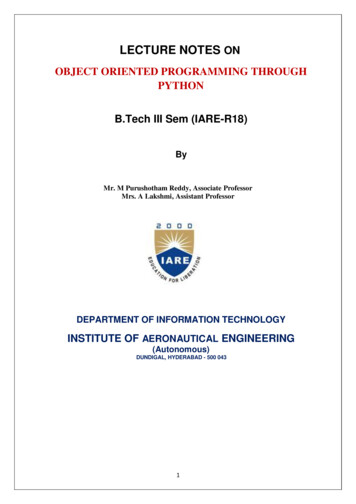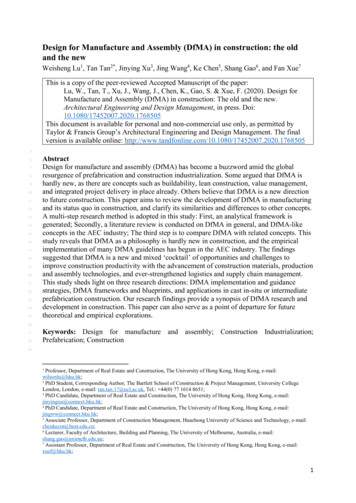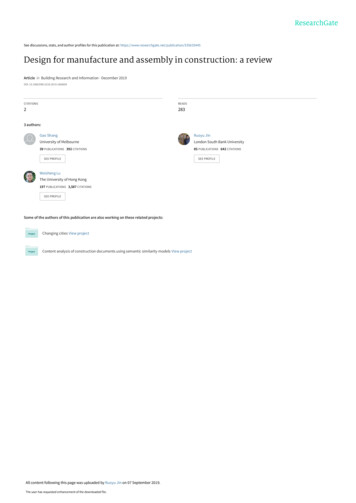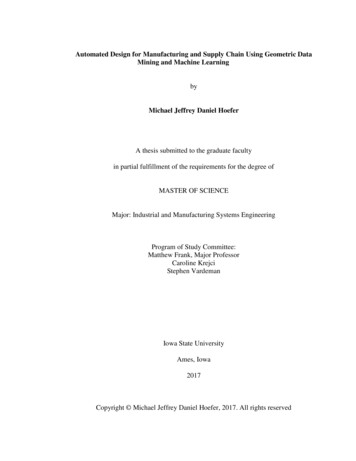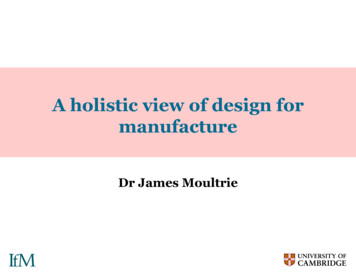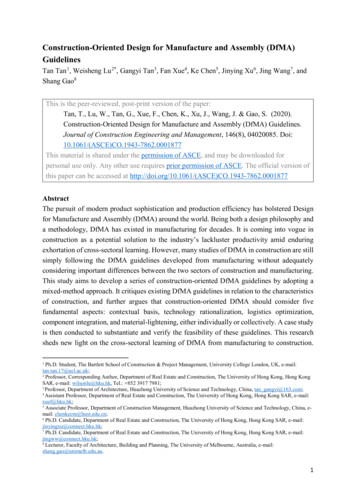
Transcription
Construction-Oriented Design for Manufacture and Assembly (DfMA)GuidelinesTan Tan 1, Weisheng Lu 2*, Gangyi Tan3, Fan Xue4, Ke Chen5, Jinying Xu6, Jing Wang7, andShang Gao8This is the peer-reviewed, post-print version of the paper:Tan, T., Lu, W., Tan, G., Xue, F., Chen, K., Xu, J., Wang, J. & Gao, S. (2020).Construction-Oriented Design for Manufacture and Assembly (DfMA) Guidelines.Journal of Construction Engineering and Management, 146(8), 04020085. Doi:10.1061/(ASCE)CO.1943-7862.0001877This material is shared under the permission of ASCE, and may be downloaded forpersonal use only. Any other use requires prior permission of ASCE. The official version ofthis paper can be accessed at bstractThe pursuit of modern product sophistication and production efficiency has bolstered Designfor Manufacture and Assembly (DfMA) around the world. Being both a design philosophy anda methodology, DfMA has existed in manufacturing for decades. It is coming into vogue inconstruction as a potential solution to the industry’s lackluster productivity amid enduringexhortation of cross-sectoral learning. However, many studies of DfMA in construction are stillsimply following the DfMA guidelines developed from manufacturing without adequatelyconsidering important differences between the two sectors of construction and manufacturing.This study aims to develop a series of construction-oriented DfMA guidelines by adopting amixed-method approach. It critiques existing DfMA guidelines in relation to the characteristicsof construction, and further argues that construction-oriented DfMA should consider fivefundamental aspects: contextual basis, technology rationalization, logistics optimization,component integration, and material-lightening, either individually or collectively. A case studyis then conducted to substantiate and verify the feasibility of these guidelines. This researchsheds new light on the cross-sectoral learning of DfMA from manufacturing to construction.Ph.D. Student, The Bartlett School of Construction & Project Management, University College London, UK, e-mail:tan.tan.17@ucl.ac.uk;2Professor, Corresponding Author, Department of Real Estate and Construction, The University of Hong Kong, Hong KongSAR, e-mail: wilsonlu@hku.hk, Tel.: 852 3917 7981;3Professor, Department of Architecture, Huazhong University of Science and Technology, China, tan gangyi@163.com;4Assistant Professor, Department of Real Estate and Construction, The University of Hong Kong, Hong Kong SAR, e-mail:xuef@hku.hk;5Associate Professor, Department of Construction Management, Huazhong University of Science and Technology, China, email: chenkecm@hust.edu.cn;6Ph.D. Candidate, Department of Real Estate and Construction, The University of Hong Kong, Hong Kong SAR, e-mail:jinyingxu@connect.hku.hk;7Ph.D. Candidate, Department of Real Estate and Construction, The University of Hong Kong, Hong Kong SAR, e-mail:jingww@connect.hku.hk;8Lecturer, Faculty of Architecture, Building and Planning, The University of Melbourne, Australia, e-mail:shang.gao@unimelb.edu.au.11
The guidelines can be used as the benchmark for the evaluation of manufacturability andassemblability in practice. It also opens up a new avenue for further DfMA studies inconstruction.Keywords: Design for manufacture and assembly; Architecture; Construction; Manufacturing;Assembly; Design guidelinesIntroductionDesign for Manufacturing and Assembly (DfMA) is both a design philosophy and methodologywhereby the downstream processes of manufacturing and assembly are considered whendesigning products (Boothroyd, 2005). Originating from the manufacturing industry, DfMAsuggests a systematic design process that integrates the production experience into the productdesign (Corbett et al., 1991; Kuo et al., 2001; Harik and Sahmrani, 2010). It has two components:design for manufacture (DfM) and design for assembly (DfA). DfM compares selectedmaterials and manufacturing processes for the parts, determines the cost impact of thosematerials and processes, and finds the most efficient use of the component design (Ashley,1995), while DfA addresses the means of assembling the parts (Bogue, 2012). Altogether,DfMA represents a shift from a traditional, sequential approach to a non-linear, reiterativedesign methodology. Since its emergence during World War II and flourishing in the1960s 1970s, numerous DfMA guidelines (e.g., Boothroyd, 2005; Swift and Brown, 2013;Bogue, 2012; Emmatty and Sarmah, 2012) have been developed to help designers to operatethis design philosophy to improve designs, productivity and profitability (Gatenby and Foo,1990; Kuo et al., 2001). More recently, a ‘Design for Excellence’ (DfX) approach hasdeveloped where the ‘X’ may denote excellence in any aspect, including testability, compliance,reliability, manufacturability, inspection, variability, and cost (Maskell, 2013; Huang, 2012).DfMA is now beginning to come into vogue in the construction industry. Notably, the RoyalInstitute of British Architects (RIBA) (2013) published a DfMA overlay to its Plan of Work2013. The governments of the UK, Singapore, and Hong Kong have all published DfMA guidesor emphasized its importance in construction. Industry giants such as a Laing O’Rourke (2013)and Balfour Beatty (2018) have even indicated that they consider DfMA to be the future ofconstruction.Some terminologies need to be clarified here. According to Dainty et al. (2007), precisely whatconstitutes construction is subject to a range of boundary definitions. There are narrow andbroad definitions of construction (Pearce, 2003). The narrow definition of construction focuseson onsite assembly and the repair of buildings and infrastructure. Contrastingly, the broaddefinition of construction could include quarrying of raw materials, manufacture of buildingmaterials, sale of construction products (Dainty et al., 2007), and professional services such asarchitectural design, urban planning, landscape architecture, engineering design, surveying,2
construction-related accountancy, and legal services (Jewell et al., 2014). All the above subsectors can be allocated a four-digit U.S. SIC (Standard Industrial Classification) code, whichis in accordance with the United Nation’s International SIC or the U.K. SIC (Lu et al., 2013).At the risk of oversimplification, this study treats upstream architecture and engineeringactivities as “design”, and downstream onsite activities as “construction”. Onsite constructionis traditionally conducted using cast in-situ; it is a combination of fabrication and assembly(Ballard and Howell, 1998). In recent years, the global construction industry has seen a numberof initiatives to minimize onsite construction, shifting it to downstream offsite“manufacture”/fabrication but bringing it back onsite for “assembly” (Duncan in RIBA 2013).To understand the concept of DfMA in construction, one must position it in the heterogeneouscontext of construction and be cognizant of the relationships between architecture, engineering,construction, manufacturing, and assembly therein.One can also understand the DfMA trend against the background of global construction, whichis characterized by ever-heightened product sophistication, sluggish productivity growth,increasing influence of cross-sectoral learning, and emerging technological advancements invirtual design and construction. Production inefficiency in construction has been criticized in asuccession of influential UK-based industry reports, including ‘Constructing the Team’(Latham, 1994), ‘Rethinking Construction’ (Egan, 1998), ‘Never Waste a Good Crisis’(Wolstenholme et al., 2009), and more recently in The Economist (2017) comparingconstruction productivity with its manufacturing and agriculture counterparts. Construction hasbeen accused of being ‘adversarial’, ‘ineffective’, ‘fragmented’, and ‘incapable of delivering’,with an appalling backwardness that should be improved, e.g., through industrial structure ororganizational culture. Increasingly, it is exhorted that construction should look to and learnfrom highly productive industries such as advanced manufacturing (Camacho et al., 2018).Lean construction (Koskela, 1992) is typically advocated as a result, as is DfMA.The exploration of production innovation, in particular offsite construction, has provided anunprecedented opportunity for DfMA. It is the similarities between offsiteconstruction/prefabrication and manufacturing that have pushed DfMA to the fore of theindustry’s cross-sectoral learning and innovation agenda. In addition, emerging technologicaladvancements, such as Building Information Modelling (BIM), 3D printing, the Internet ofThings (IoTs), and robotics provide the construction industry, DfMA in particular, new entrypoints for manufacturing knowledge and efficiency improvement.However, current DfMA practices in construction still, by and large, follow DfMA guidelinesdeveloped in a manufacturing context without sufficiently considering the differences betweenconstruction and manufacturing. For example, DfMA procedures in Boothroyd (2005) considerDfA and DfM but not the downstream logistics and supply chain (LSC), which plays a criticalrole in offsite prefabrication construction. Some construction DfMA guidelines proposed, e.g.,3
Gbadamosi et al., (2019), Kim et al., (2016), and Banks et al. (2018), originate more or lessfrom manufacturing-oriented guidelines. While inspiring, some of these guidelines are notnecessarily a good fit with construction’s characteristics, leading to an inability to improvemanufacturing and assembly. Some guidelines are proposed in a fragmented fashion withoutnecessarily forming an organic whole, leading to a lack of comprehensiveness, or “easy to use”throughout the building process. The RIBA, in recognizing the potential of DfMA inconstruction, added an overlay of DfMA to its time-honored Plan of Work. Following RIBA’svision (2013, p. 24), much “soft-landing” work remains to implement DfMA in construction.Partly responding to this call for “soft-landing” work, this paper aims to facilitate theimplementation of DfMA in construction by proposing a series of construction-oriented DfMAguidelines. It has three objectives: (1) to identify the differences between manufacturing andconstruction; (2) to propose a series of construction-oriented DfMA guidelines; and (3) toevaluate the proposed DfMA guidelines by using empirical evidence. These objectives areachieved using a mixed-method approach including literature review, comparative analysis, andcase study. The remainder of this paper is organized into six sections. Section 2 presents basicknowledge such as the origin, concept, and general applications of DfMA. Section 3 describesthe research methods adopted. Section 4 introduces the development of DfMA guidelines forconstruction projects by adapting existing DfMA guidelines to fit the characteristics of thedesign process and the final product in construction. In Section 5, the developed DfMAguidelines are evaluated through empirical evidence from research and practice. The last twosections present discussions and a conclusion, respectively.An overview of Design for Manufacture and AssemblyDfMA originated in the weapon production processes developed by Ford and Chrysler duringWorld War II. Formal approaches to DfM and DfA emerged in the late 1960s and early 1970swhen the UK published The Management of Design for Economic Production standard in 1975.The academic exploration of DfMA can be traced back to the 1970s when Boothroyd andDewhurst conducted research and practice in this area. Boothroyd (1994) described theshortcomings of an “over the wall” design approach and suggests the application of DfMAmethodology to making production knowledge available to designers. Hamidi and Farahmand(2008) suggested that DfMA implementation needs a feedback loop between design andmanufacturing; for example, with a design being checked by the manufacturer to identifypotential problems or waste in the downstream processes of manufacturing and assembly.Since its adoption in manufacturing, DfMA has helped many companies increase their profitsthrough optimized design (Gatenby and Foo, 1990; Kuo et al., 2001). Several guidelines havebeen consolidated to help designers reduce difficulties in manufacturing and assembling aproduct. Examples include minimizing the number of parts (Kuo et al., 2001; Eastman, 2012;Bogue, 2012) and searching for the most efficient use of modular design (Ashley, 1995). Some4
analytical tools have also been developed for designers to evaluate their proposed design fromthe perspectives of manufacturing and assembly difficulties. Although theseguidelines/principles have been developed from various reference points, they share substantialsimilarities, with minimization, standardization, and modular design emerging as key DfMAprinciples.The importance of considering the production process in the design stage is also recognized bythe construction industry. Architectural and engineering design have never been a pure art; thereis a long-standing architectural philosophy of “form follows function” (Goulding et al., 2015)whereby form, functions, quantity, and buildability should be considered in design. Designoptimization has been advocated. But DfMA is different in that it consciously highlights thedownstream processes of manufacturing and assembly. With its success in the manufacturing,civil aviation, auto, and other industries, researchers have suggested the implementation ofDfMA in construction to harvest benefits including time reduction, cost minimization, andachieving customer satisfaction. Although DfMA has only recently been introduced toconstruction, some DfMA-like thinking precedes it. For example, Fox et al. (2001) proposed astrategy for DfM application to buildings, and Crowther (1999) proposed design fordisassembly as the final step of DfA in construction for life cycle assemblability. More recently,Yuan et al. (2018) integrated BIM and DfMA to develop the concept and process of DfMAoriented parametric design, and Arashpour et al. (2018) explained DfMA guidelines in modularprefabrication of complex façade systems. Chen and Lu (2018) also highlighted the applicationof DfMA in the façade system through a case study. In addition to this research work, industrialreports such as Laing O’Rourke (2013), Balfour Beatty (2018), and RIBA’s DfMA overlay(2013) have helped popularize DfMA in construction.Despite support from both academia and industry, DfMA has yet to achieve ferventimplementation in construction because of problems related to new design system andstandardization, fragmentation, multi-party coordination, and lack of proper design guidelines(Jin et al., 2018; Gao et al., 2019). Few studies, if any, have discussed the differences of DfMA'sguidelines between manufacturing and construction. Indiscriminate introduction of guidelinesfrom a manufacturing to construction may not increase productivity, and will definitely poseadditional uncertainties and risks (Paez et al. 2005).Research methodsThis study adopts a four-step research design, as shown in Figure 1. The first step is to reviewfundamental guidelines of DfMA widely adopted in the manufacturing industry. Theseguidelines are retrieved from authoritative publications, including academic papers and reports.Some of these guidelines can be applied to the design of building components for efficientconstruction, but others cannot. Therefore, the second step is to generate a tentative set of DfMAguidelines applicable to construction. This process is delivered based on an understanding of5
the similarities and differences between construction and manufacturing. The third step is tocomplement the tentative DfMA guidelines by analyzing construction projects that havepioneered DfMA-oriented design. The set of DfMA guidelines will be further validated in thefourth and final step of this study.Fig. 1. Research design and methodsThree principles underpin the transplantation of DfMA guidelines from manufacturing toconstruction. The first is to reduce inappropriate guidelines and merge or amend vagueguidelines. Some guidelines that cannot meet the production requirements of construction dueto its unique characteristics will be deleted. Guidelines that are too vague or not amenable toaccurate and efficient implementation will be re-organized or re-presented. The secondprinciple is to increase applicable guidelines in line with the unique characteristics ofconstruction. Manufacturing-oriented DfMA guidelines may not fully describe the needs ofmanufacturability and assemblability in construction projects. Properly enhanced, these DfMAguidelines, however, can provide decision-makers with adequate design options. The thirdprinciple is to establish DfMA guidelines using a systems theory lens. Many DfMA guidelinesdeveloped from the manufacturing industry are, in fact, appropriate only from a microperspective. Using these guidelines discretely without systematic consideration might notincrease manufacturability and assemblability in real-life construction projects.Towards construction-oriented DfMA guidelinesDfMA guidelines for manufacturingDfMA signifies a shift in traditional, sequential design thinking to a non-linear, reiterativemethodology by actively considering the downstream processes in the upfront design stage.Researchers such as Stoll (1986), Swift and Brown (2013), Bogue (2012), and Emmatty andSarmah (2012) provided some key guidelines for the application of DfMA in manufacturing,as shown in Table 1. Their focal points are mainly related to design, fabrication, assembly, andmaterials. From Table 1, it is clear that simplification and the assembly process are spotlighted.6
The guidelines are descriptive and qualitative, with no quantitative, implementable, andnumerical details that are easy to comprehend and execute. While some of the principle aspectsare relevant to construction, the guidelines when proposed did not necessarily consider theheterogeneity of construction.Table 1. A non-exhaustive list of DfMA guidelinesGuidelines1Aim for mistake-proof designPerspectivesSD2Design for ease of fabricationF; SP3Design for simple partorientation and handlingDesign with a predeterminedassembly technique in mindDesign multifunctional andmulti-use partsConsider modular designsF; SPConsiderdesignformechanized or automatedassemblyUse standard and off-the-shelfcomponentsUse as similar materials aspossibleUseasenvironmentallyfriendly materials as possibleMinimize the part countSP; AMinimize and standardiseconnector types and quantityMinimize the use of fragilepartsDo not over-specify tolerancesor surface finishSP;SDSP4567891011121314FF; SP;SDSP; MSP; M;SDSP; MSPF; SPBenefitsAvoids unnecessary re-work, improve quality,reduce time and costsReduces time and costs by eliminating complexfixtures and toolingReduces time and costs by avoiding non-valueadding manual effortReduces time and costs when assemblingReduces time with fewer manufacture processesand simplified jointingReduces time and costs due to simplified design andassemblyImproves assembly efficiency, quality, and securityReduces purchasing lead time and costsReference①; ②;③; ④①; ②;④①; ②;④①; ④②①; ②;③; ④①; ③;④Reduces time with fewer manufacture processesand simplified jointingReduces harm to the environment and residents①; ②;③; ④①; ④Reduces time and costs with simplified design,manufacture, and assemblyReduces time and costs with simplified design,manufacture, assembly, repair and maintenanceReduces costs due to fewer part failures, and easierhandling and assemblyReduces time and costs with easier manufacture①; ②;③; ④①; ②;③; ④①; ④Note: A Automation; F Flexibility; M Modularity; SD Standardization; SP Simplification.① Bogue, 2012; ② Stoll, 1986; ③ Emmatty and Sarmah, 2012; ④ Swift and Brown, 2013③①; ④Similarities and differences between manufacturing and constructionTransplanting DfMA guidelines from manufacturing to construction first requiresunderstanding the connections and distinctions between the two industries. Manufacturing canbe defined as “the process of transforming materials and information into goods for thesatisfaction of human needs” (Chryssolouris, 2013). It is often linked to the concept of “massproduction”, evolving to successfully adopt machinery and information technologies to achievecost-effective production (Lanigan, 1992; Crowley, 1998). Construction can also be consideredas production process with products that are location-based and involve heavier onsite assembly,e.g., buildings, bridges, roadways, and other infrastructure (Jewell et al., 2014). It is a projectbased activity employing huge human, material, and machine resources and involving heavyinvestment (Chitkara, 1998).7
Manufacturing and construction share many managerial practices, however. For example, theyboth engage multiple stakeholders to participate in the design, procurement, production, andlogistics and supply chain management (LSCM) process (Winch, 2003). The process ofproducing physical products can be intensive, and thus requires skilled labor and a high levelof technology (Sanvido et al., 1990). In recent years, as construction shifts towardsprefabrication and other manufacturing techniques, the distinctions between these twoindustries have blurred. Some scholars advocate construction as a manufacturing process,intending to encourage adoption of manufacturing processes and guidelines (e.g., Crowley,1998; Gann, 1996). The underpinning idea is to make the construction process morecontrollable to alleviate the long-lasting problems of the industry such as low efficiency, poorquality control, and labor shortage.Still, construction differs from manufacturing in its end products and production process.Construction outputs are generally more sophisticated (Sanvido et al., 1990). Unlikemanufacturing goods produced at factories and transported to end users, construction outputsare largely built in place (Paez et al., 2005). The unique features of construction outputs lead tothe more dynamic, highly localized, and complex nature of construction process. For example,construction involves an onsite production cycle that could last for years and manycontingencies and risks can occur during this period (Koskela, 1992; Paez et al., 2005). It ischallenging for proactive planning, visual control, and orderly management (Aapaoja andHaapasalo, 2014). Compared to manufacturing with its relatively standardized workflow,construction is a highly localized activity that involves using locally available resources andtaking into account local geographic, economic, social and climatic constraints (Akanni, et al.,2015). The site-specific, one-of-a-kind nature of construction projects makes it difficult to applya standardized routine that has been proved efficient by other projects (Koskela, 1992; Jewellet al., 2014; Aapaoja and Haapasalo, 2014).Even though offsite construction is quite similar to manufacturing and hence presents anunprecedented opportunity for DfMA, they are not the same. Some major components can bemanufactured, e.g., in an offsite precast yard, but a considerable portion of the construction andassembly work are still conducted onsite. Full modular integrated construction has never beenthe ultimate choice (Lu et al., 2018b). Construction LSCM of raw materials and precastcomponents play a key role in the success or failure of prefabrication construction (Zhong etal., 2017). The final products are still location-based, confined by site conditions and bespokerequirements from diverse clients. As shown in Table 2, the differences mentioned above aresummarized into six perspectives, including place, power, mode, form, period, and process. Allthese features together necessitate a closer look at “general” manufacturing DfMA guidelinesto propose a set of guidelines that are more construction-oriented.8
Table 2. Difference between manufacture industry and construction industryPerspectives Manufacture industry Construction industryPlaceLowly localized activity Highly localized activityPowerFactory mechanization Labor-intensive onsiteModeMass productionCustomized designFormProduct-based activityProject-based activityPeriodShort cycleLong cycleProcessStandardized workflow Non-standardized workflowTentative DfMA guidelines for constructionSeveral studies have tried to apply DfMA in construction, as shown in Table 3. Most of theseguidelines directly adopted the manufacturing-oriented DfMA (see Table 1) or made someadaption, mainly by changing their descriptions . Gbadamosi et al. (2019) generalized the fourcategory of guidelines by considering DfMA and lean construction and developed a DfMAbased optimizer for improving constructability. Kim et al. (2016) employed DfMA to overcomethe limitations of current bridge construction practice and to realize the standardization ofbridge construction in the UK. Chen and Lu (2018) reported DfMA guidelines for curtain wallsystem specifically. Banks et al. (2018) introduced DfMA to support high-rise residentialconstruction. Safaa et al. (2019) proposed DfMA-based evaluation criteria for the prefabricatedbridge.However, these studies do not adequately discuss the DfMA guidelines applied. Meanwhile,some of the stated guidelines are inconsistent with current architectural and engineering designpractices. Hence, they cannot represent the core ideas of DfMA, such as improvingmanufacturability and assemblability without reducing flexibility and functionality. ManyDfMA guidelines only consider reducing cost and number of components, not maintaining andbalancing other building attributes, and therefore cannot be used directly. More seriously, theseguidelines may make sense when being implemented individually, but can be easilycontradictory to each other if being applied together. Therefore, more systematic and iteratedguidelines need to be developed.Considering context specificity and technical limitations, this study treats DfMAimplementation as a multi-criteria decision-making (MCDM) issue in the evaluation andoptimization of manufacturability and assemblability. Through systematical consideration,these guidelines can be assigned importance weights during project process to achieve overalloptimization. Therefore, this research derive the five construction-oriented DfMA guidelinesshown in Table 4. The generalization of these guidelines is grounded based on the combinedconsideration between existing DfMA guidelines and construction characteristics. Most of theguidelines mentioned in Table 3 are summarized into component-integrated design which ismore closed to manufacture-oriented DfMA. Part of the guidelines are summarized into9
material-lightened design, logistics-optimized design, and technology-rationalized design. Inaddition, the inherent differences between the construction and manufacturing industries leadto a new DfMA guideline – context-based design – for construction because the construction isgenerally a highly localized activity (Akanni et al., 2015). Detailed descriptions of these fiveguidelines are shown as follows.Table 3. Some construction-related DfMA guidelines reported in the literature1ReferenceGbadamosi etal.,(2019)GuidelinesSources(1) ease of assembling partsMinimize and standardise connector types andquantity (①; ②; ③; ④); Use standard and offthe-shelf components (①; ②; ③; ④)Design for simple part orientation and handling(①; ②; ④); Minimize the part count (①; ②;③; ④)Design with a predetermined assembly techniquein mind (①; ④)Use as environmentally friendly materials aspossible (③)Design for ease of fabrication (①; ②; ④);Design for simple part orientation and handling(①; ②; ④)Minimize the part count (①; ②; ③; ④)Minimize and standardise connector types andquantity (①; ②; ③; ④); Use as similarmaterials as possible (①; ④)Design for simple part orientation and handling(①; ②; ④)Minimize the part count (①; ②; ③; ④)(2) ease of handling parts(3) speed of assembling the whole system(4) waste produced during operation2Kim etal.,(2016)(1) simplification in design(2) reduced number of parts(3) standardization of commonly used partsand materials34Chenand Lu(2018)Bankset al.(2018)(4) ease of orientation, handling andassembly of parts(1) reducing the part count of curtain wallsystem(2) reducing the numbers of uniquefasteners necessary to assemble the curtainwall system on the construction site(3) using cost-effective materials(4) making sure that the size and weight ofcomponents is easy to handle(5) reducing waste of materials(1) use of prefabricated elements andmodules(2) reducing the number of unique parts(3) removing labor-intensive constructionactivities from site(4) placing the prefabrication activities in acontrolled factory environment(5) using a highly automated approach(6) reducing waste in the process overall(7) improving efficiency in site logisticsand a reduction in overall vehiclemovements transporting materials to andfrom siteMinimize and standardise connector types andquantity (①; ②; ③; ④)Use as similar materials as possible (①; ④)Design for simple part orientation and handling(①; ②; ④)Use as environmentally friendly materials aspossible (③)Use standard and off-the-shelf components (①;②; ③; ④)Minimize and standardise connector types andquantity (①; ②; ③; ④); Minimize the partcount (①; ②; ③; ④)Consider design for mechanized or automatedassembly (①; ③; ④)Consider design for mechanized or automatedassembly (①; ③; ④)Consider design for mechanized or automatedassembly (①; ③; ④)Use as environmentally friendly materials aspossible (③)N/A10
5Safaaet al.,(2018)(8) lowering the number of parts(9) reducing the proportion of work carriedout in the relatively harsh site environment(1) simplicity of design(2) number of components(3) standardization on elements or material(4) ease of handlingMinimize the part count (①; ②; ③; ④)Consider d
suggests a systematic design process that integrates the production experience into the product design (Corbett et al., 1991; Kuo et al., 2001; Harik and Sahmrani, 2010). It has two components: design for manufacture (DfM) and design f
